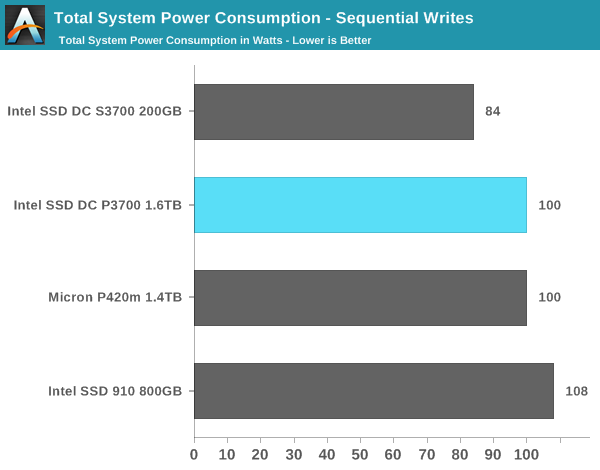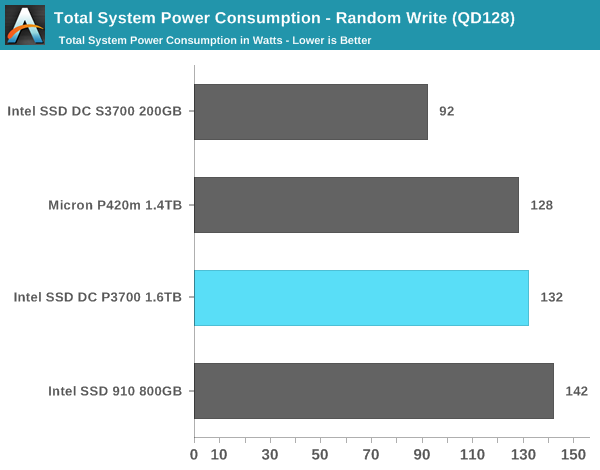Intel SSD DC P3700 Review: The PCIe SSD Transition Begins with NVMe
by Anand Lal Shimpi on June 3, 2014 2:00 AM EST- Posted in
- Storage
- SSDs
- Intel
- Intel SSD DC P3700
- NVMe
Power Consumption
To quantify power consumption we're looking at total system power, which takes into account the CPU load associated with workload generation as well as the power drawn by the drive itself. The P3700 was left in its default lower power operating mode, not the higher 25W mode.
Overall the P3700 doesn't raise any power consumption flags. The overall system power consumption ends up being around 16W higher than with a single S3700, but if you normalize for performance the two end up looking quite similar. There seems to be some power savings compared to the old Intel SSD 910, and roughly comparable power consumption to the P420m.












85 Comments
View All Comments
jamescox - Monday, June 9, 2014 - link
"Why isn't the new spec internal thunderbolt?"Thunderbolt is PCI-e x4 multiplexed with display port. Intel's new SSD is PCI-e x4. I don't think we have a reason to route display port to an SSD, so thunderbolt makes no sense. Was this sarcasm that I missed?
"At some point the hard drive should be replaced by a PCI-express full length card that accepts NAND cards, and the user simply buys and keeps adding cards as space is required. This can already be done with current technology, no reinventing the wheel required."
What protocol are the NAND cards going to use to talk to the controller? There are many engineering limitations and complexities here. Are you going to have 18 channel controller like this new Intel card? If you populate channels one at a time, then it isn't going to perform well until you populate many of the channels. This is just like system memory; quad channel systems require 4 modules from the start to get full bandwidth. It gets very complicated unless each "NAND card" is a full pci-e card by itself. Each one being a separate pci-e card is no different from just adding more pci-e cards to your motherboard. Due to this move to pci-e, motherboard makers will probably be putting more x4 and/or x8 pci-e slots with different spacing from what is required by video cards. This will allow users to just add a few more cards to get more storage. It may be useful for small form factor systems to make a pci-e card with several m.2 slots since several different types of things (or sizes of SSDs) can be plugged into it. This isn't going to perform as well as having the whole card dedicated to being a single SSD though. I don't think you can fit 18 channels on an m.2 card at the moment.
Anyway, most consumer applications will not really benefit from this. I don't think you would see too much difference in "everyday usability" using a pci-e card vs. a fast sata 6 drive. Most consumer applications are not going to even stress this card. I suspect that sata 6 SSDs wil be around for a while. The SATA Express connector seems like a kludge though. If you actually need more performance than sata 6 (for what?), just get the pci-e card version.
jeffbui - Thursday, June 5, 2014 - link
"I long for the day when we don't just see these SSD releases limited to the enterprise and corporate client segments, but spread across all markets"Too bad Intel is all about profit margin. Having to compete on price (at low profit margins) gives them no incentive to go into the consumer space.
sethk - Saturday, June 7, 2014 - link
Hi Anand,Long time fan and love your storage and enterprise articles, including this one. One questions - what the driver situation on NVMe as far as dropping one of these into existing platforms (consumer and enterprise) and being able to boot?
Another question is regarding cabling for the non-direct PCIe interfaces like SataExpress and SFF-8639? It would be great if you could have some coverage of these topics and timing for consumer availability when you do your inevitable articles on the P3600 and P3500 which seem like great deals given the performance.
T2k - Monday, June 16, 2014 - link
How come you did not include ANY Fusion-IO card? In enterprise space they are practically cheaper than the P3700 and have far bigger sizes, for less money, consistently low latency, not to mention advanced software to match it... was it a request from Intel to leave them out?SeanJ76 - Wednesday, May 20, 2015 - link
Intel has always been the best in SSD performance, and longevity. I own 3 of the 520 series(240GB) and have never had a complaint.